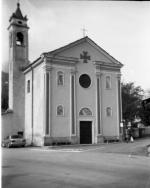|
Konica MS-40 |
Manufactured or assembled in Japan from 1989 to (After) 1989.
Index of rarity in France: Rare (among non-specialized garage sales)
Inventory number: 12453
See the complete technical specifications
Chronology of cameras Konica
It was presented at the Photokina in1988 under the "name" of VCW, and then was presented at the SITI show in 1 989 under the final name of MS-40.
It is part of a range of "Heavy Duty" Konica with the various names: "Off-road", "Genba Kantoku", "MR.640." All are more or less reinforced to withstand salt spray, dust, sand, shocks, but none is actually submersible. In this, these devices remain below the Fuji HD.
The MS-40 is noted for its array of infrared transmitters and receivers that are acting for its autofocus system and the kind of window that protects the lens. Its khaki colour and the rubber reinforcements make it looking like a military equipment.
Controls are oversized enough to allow their use with gloves. The ergonomics of the right side has been particularly studied. The big rubber bump has it efficiency reinforced by the marking "Konica" which serves as an anti-skidding. The two trigger buttons and various controls are very well positioned under the right index finger. The button has a different action depending on the number of pressure being done upon it. This avoids looking at the LCD.
Under the thumb is the memory button.

History
1873 Establishment of the Konishi-ya company. Initial implementation of photographic and lithographic materials.
1876 Relocation to Tokyo. The company is renamed Konishi Honten.
1882 Three factories are established in Tokyo, producing photographic equipment, coated paper, and lithography equipment.
1897 Introduction of the first cinematographic cameras in Japan, enabling the production of Japanese films.
1902 Establishment of a new factory in Tokyo dedicated to the production of photographic plates and papers. This factory is considered the birthplace of the Japanese photographic industry.
1903 The first photosensitive paper produced in Japan, Sakura Hakkin type paper, and the Cherry camera are introduced to the market.
1909 Opening of the Osaka Agency. Introduction of the LiIy camera.
1919 Consolidation of factories in Tokyo, forming Japan's first modern photographic organization.
1921 This organization becomes the Konishiroku Honten Company (Honten = headquarters).
1925 Introduction of Pearlette cameras.
1929 Launch of Sakura films (Sakura = Japanese cherry blossom).
1933 Expansion of the headquarters.
1936 The company becomes Konishiroku Co., Ltd. Opening of an agency in Hino, and relocation of the Sensitive Materials Production Division.
1938 Introduction of the Semipearl camera.
1940 Announcement of the production of the first Japanese color film, Sakura Natural Color Film.
1943 The company adopts its current name, Konishiroku Photo Industry Co., Ltd., and the factories are renamed.
1944 Merger with Showa Photo Industries Co., Ltd., adding the Odawara and Koyama factories to the company.
1945 End of the war, leading to a chaotic economic situation. A major reorganization is undertaken to enable the company to survive this tumultuous period.
1948 Sale of the first KONICA-branded cameras and resumption of exports.
1963 Inauguration of the large factory for the production of photographic equipment.
1967 Introduction of the world's great innovation, the SAKURACOLOR N-100, along with the world's first automatic reflex, the KONICA AUTO-REFLEX.
1968 The first automatic reflex camera (EE) incorporates through-the-lens (TTL) metering: it becomes the KONICA AUTOREFLEX T. Production of the first Japanese 24 x 36 compact rangefinder camera, the KONICA C35, in the same year.
1969 Development by Konishiroku of the world's first compact holographic camera.
1970 Start of the sale of U-Bix electrostatic dry photocopying machines. Introduction of SAKURA High Resolution Plate, ultra-fine grain, high-resolution sensitive material essential for Integrated Circuit manufacturing.
1971 Introduction of the new SAKURACOLOR. Commencement of U-Bix MARK I export.
1973 Celebration of the 100th anniversary of the company. Adoption of the new logo. Departure for a new century with renewed enthusiasm.
Interesting links or bibliography :
Add a link or element of bibliography, a picture taken with this camera, a picture of box or an ads about this camera
Your photos taken with the same camera:
Cameras from Ebay France (Konica) (Uploaded each 3 hours)
 Appareil De Photo Konica 30,00 euros Finira le 04-05-2024 à 15:07:46 |  Konica C35 EFP Lens 38mm F4 Appareil photo argentique - Non Testé - Pour Pièces 1,00 euros Finira le 04-05-2024 à 16:43:13 |  Appareil photo Compact * Konica BM-S 248Z * argentique vintage 24-48 mm 27,50 euros Finira le 04-05-2024 à 16:22:14 |  APPAREIL PHOTO KONICA EF-88 non testé en l'etat 10,00 euros Finira le 06-05-2024 à 11:42:36 |








